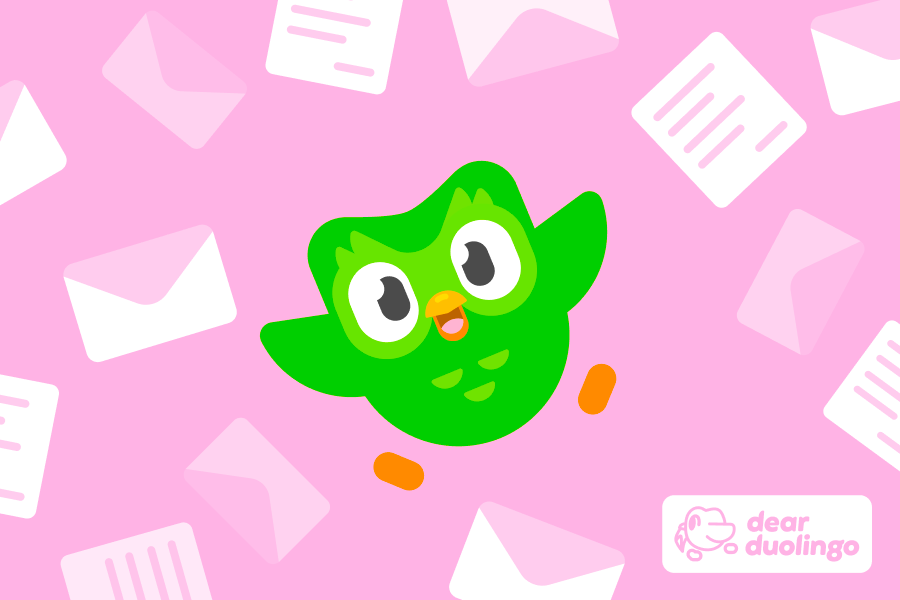Welcome to another week of Dear Duolingo, an advice column just for learners. Catch up on past installments here.
Hey there, learners! We're back this week with one of our most popular questions. It doesn't have an easy answer, but in this post you'll find a step-by-step guide you can use for any language you're learning. Here's our question:
This week's question

This process of translating in your head is totally normal, especially for beginner and intermediate learners… and it sure can feel frustrating! Our brains naturally turn to the language they know best because these neural connections are the strongest. To use a new language quickly and effectively, you'll want to work towards going right from an idea to how you express it in the language you're learning—without translating first.
But how?
The truth is that learning to think in a language requires a lot of practice—and a lot of patience—but it's never too soon to start trying! This week, I describe what I like to do when I'm learning a new language, starting from when I only know a few words, so intermediate learners may want to skip the first steps. You may find other techniques that you like, too!
Ground rules
Treat this thinking exercise like a game, especially until you get the hang of it. There are three rules I like to follow—and the first is crucial.
This is harder than it seems, and at the beginning, you won't know very much! That's ok and in fact, that's the point: To build up this new thinking skill, work on building strong connections for the words you know best, the ones that come to you most easily. If you don't already know a word, then don't include it in your thinking exercise.
For most learners, using the language in conversations is the real goal, so don't just think to yourself in the language—talk to yourself in the language! If possible, find places where you can talk out loud comfortably, like at home by yourself, to your pets, on a walk in the park, etc. (You can even put on headphones to pretend that you're on the phone with someone!)
In order to learn to think in your new language:
- 🥴 You are going to feel foolish.
- 🤐 You won't be able to say very much.
- 🥱 You won't sound smart or interesting.
- 😱 You are going to make lots of mistakes. (But that's the point! Work through those mistakes! Get used to making mistakes!)
Ok, on your mark… get set… THINK!
Step 1: Think words you know
Start small and start easy. The goal of this first stage is to start building connections directly between ideas and words you know, and skip over that translation step. What you think (or say out loud) doesn't have to make sense, and it doesn't have to be sentences or even phrases. Just start thinking those isolated words!
If you were learning English, that might mean thinking: Coffee… man… girl… and… the… And that is good enough! The goal here is just to use what you know and think think think.
How to use your lessons to help: Take screenshots of words and phrases you wish came to you more easily, and dedicate a thinking session to including a few of them.
Step 2: Think little sentences
In this step, start grouping words together. You don't have to make real sentences, but maybe you think Coffee and tea instead of the individual words. The phrases or sentences can be simple, boring, and repetitive—it depends on what you've learned and what's easiest for you to pull from your memory. Remember Rule #1: Stick to what you know!
Here, the goal is to keep strengthening the connections between words and ideas and to start making what you're thinking a bit more practical. There are simple ways to do this if you're very new to the language, like by using and to connect words, and once you start learning some verbs, you can incorporate those: The coffee is here, the tea is here, the man is here, the girl is here.
As you progress through your lessons, you'll probably find that you move back and forth between steps 1 and 2: Maybe for brand new words, you like to practice thinking them individually, and you eventually start including them in the phrases and sentences you know. As you study the language longer, you'll be able to include brand-new words right into sentences and phrases.
How to use your lessons to help: When you encounter verbs or phrases that are especially relevant or interesting to you, screenshot them to include in your thinking practice. You can also do this to record phrases that you can make a lot of use of, like May I have a ___? or I'd like to ___.
Even if your goal is thinking in the new language, you can practice other skills to help. I like to write out little sentences and dialogues—also using only what I already know (Rule #1!)—to help me practice putting words together in phrases.
Step 3: Describe everything around you
Once you have more vocabulary and grammar under your belt, start narrating things to yourself. You won't sound interesting, but that's not the point 😅 Remember you want to build connections in your brain and practice thinking. Imagine it like a sport: If you're training to play tennis, you'll do lots of exercises and drills that look pretty different from what playing a real tennis match looks like. But you're building up the muscles and skills to do the real thing!
In Step 3, you'll describe actual things you see, or what you're doing, or what you imagine doing. Since you want to stick to the words you already know, you might be making a lot of this up, and it might be repetitive: I am here, I am at home, I have a bed, I have a cat, This is my bed, This is my cat, etc. Try to go on as long as you can! As you get more comfortable with these basics, you'll find it easier to include new words and make longer sentences.
How to use your lessons to help: Do a lesson (or two!) before your thinking session and get inspiration from the vocabulary and grammar you see. You can challenge yourself to think about the specific topic of the lesson, or to target your thinking to particular grammatical structures from the lesson.
Step 4: Do this as much as possible!
This isn't really a separate step—you can do this even when you only know a few words. It's great to take advantage of speaking out loud whenever possible, but you probably have even more opportunities to do thinking practice. You can quietly think words, phrases, and sentences to yourself on the bus, while walking to your car, while washing your hands, while waiting in line, while in the elevator… just about any time!
It’s like training a muscle: You need to build muscle memory, and your brain needs to get used to putting together the ideas, words, and grammar you'll need to communicate. For most learners, it's simply unrealistic to expect to jump to full sentences about relevant topics. But you can get there with practice and by starting small!
Step 5: Reflect on what's missing
Once you're at the sentence and description stages, start noticing what words and phrases you'd like to pull from your memory more easily. Keep track of them, maybe on your phone or in a notebook, and write down their equivalents when you come across them in your lessons. That way, when you're ready for another little thinking session, you can refer back to your list and include some new items in your thinking.
One thing that's nice about this low-pressure thinking technique is that it makes it easy to focus on particular grammar or vocabulary that you want extra practice with. For example, if you'll be using the new language at an upcoming family gathering, maybe you want to practice describing a recent trip—so you can focus your thinking on the past tense. What verbs do you know the past tense in really well? Which verbs have irregular conjugations or they just don't come to you as quickly?
How to use your lessons to help: Doing Legendary levels or practice for older units is a great way to gather up the vocabulary and grammar you aren't including in your thinking yet.
It's a lot to think about!
Incorporate these thinking exercises into your daily practice and spend lots of time on Step 3 to get your brain used to thinking about the real objects, routines, and needs in your daily life. Just like learning vocabulary, grammar, and pronunciation, learning to think in your new language takes a long time, so chip away at it a little every day!
For more answers to your language and learning questions, get in touch with us by emailing dearduolingo@duolingo.com.
